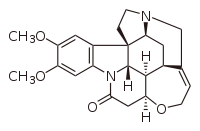Brucine
 |
|
| Names | |
|---|---|
|
IUPAC name
2,3-dimethoxystrychnidin-10-one
|
|
| Other names
2,3-Dimethoxystrychnine
10,11-Dimethoxystrychnine |
|
| Identifiers | |
|
357-57-3 |
|
| 3D model (Jmol) | Interactive image |
| ChEMBL |
ChEMBL501756 |
| ChemSpider |
390579 |
| ECHA InfoCard | 100.006.014 |
| 342 | |
| KEGG |
C09084 |
| PubChem | 442021 |
| UNII |
6NG17YCK6H |
|
|
|
|
| Properties | |
| C23H26N2O4 | |
| Molar mass | 394.47 g·mol−1 |
| Melting point | 178 °C (352 °F; 451 K) |
|
Except where otherwise noted, data are given for materials in their standard state (at 25 °C [77 °F], 100 kPa).
|
|
|
|
|
| Infobox references | |
Brucine, an alkaloid closely related to strychnine, is most commonly found in the Strychnos nux-vomica tree. Brucine poisoning is rare, since it is usually ingested with strychnine, and strychnine is more toxic than brucine. In synthetic chemistry, it can be used as a tool for stereospecific chemical syntheses.
Brucine was first discovered in 1819 by Pelletier and Caventou in the bark of the Strychnos nux-vomica tree. While its structure was not deduced until much later, it was determined that it was closely related to strychnine in 1884, when the chemist Hanssen converted both strychnine and brucine into the same molecule.
The probable fatal dose of brucine in adults is 1 g. In other animals, the LD50 varies considerably.
Brucine’s mechanism of action closely resembles that of strychnine. It acts as an antagonist at glycine receptors and paralyzes inhibitory neurons.
Glycine binds to receptors on inhibitory neurons to terminate action potentials. Its binding terminates an action potential by causing an influx of chloride ions into the neuron, repolarizing the neuron to its resting potential. Brucine also binds to these receptors, but its binding does not trigger an influx of chloride ions. Brucine's toxicity arises because glycine is blocked from binding to its receptors, making inhibition of an action potential more difficult.
Historically, brucine was distinguished from strychnine by the addition of chromic acid in H2SO4, since it does not give off the series of colors that is characteristic of strychnine.
Today, pure brucine intoxication occurs very rarely, since it is usually ingested with strychnine. Symptoms of brucine intoxication include muscle spasms, convulsions, rhabdomyolysis, and acute renal failure. Brucine can be detected and quantified using liquid chromatography-mass spectrometry.
...
Wikipedia
